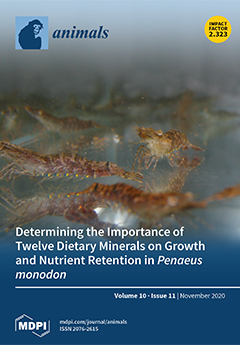Odour is one of the main environmental concerns in the laying hen industry and may also influence animal health and production performance. Previous studies showed that odours from the laying hen body are primarily produced from the microbial fermentation (breakdown) of organic materials in the caecum, and different laying hen species may have different odour production potentials. This study was conducted to evaluate the emissions of two primary odorous gases, ammonia (NH
3) and hydrogen sulphide (H
2S), from six different laying hen species (Hyline, Lohmann, Nongda, Jingfen, Xinghua and Zhusi). An in vitro fermentation technique was adopted in this study, which has been reported to be an appropriate method for simulating gas production from the microbial fermentation of organic materials in the caecum. The results of this study show that Jingfen produced the greatest volume of gas after 12 h of fermentation (
p < 0.05). Hyline had the highest, while Lohmann had the lowest, total NH
3 emissions (
p < 0.05). The total H
2S emissions of Zhusi and Hyline were higher than those of Lohmann, Jingfen and Xinghua (
p < 0.05), while Xinghua exhibited the lowest total H
2S emissions (
p < 0.05). Of the six laying hen species, Xinghua was identified as the best species because it produced the lowest total amount of NH
3 + H
2S (39.94 µg). The results for the biochemical indicators showed that the concentration of volatile fatty acids (VFAs) from Zhusi was higher than that for the other five species, while the pH in Zhusi was lower (
p < 0.01), and the concentrations of ammonium nitrogen (NH
4+), uric acid and urea in Xinghua were lower than those in the other species (
p < 0.01). Hyline had the highest change in SO
42− concentration during the fermentation processes (
p < 0.05). In addition, the results of the correlation analysis suggested that NH
3 emission is positively related to urease activities but is not significantly related to the ureC gene number. Furthermore, H
2S emission was observed to be significantly related to the reduction of SO
42− but showed no connection with the aprA gene number. Overall, our findings provide a reference for future feeding programmes attempting to reduce odour pollution in the laying hen industry.
Full article


